Beth Israel celebrates its dedication seven years after Katrina
By ALAN SMASON
Seven years after swirling floodwaters from broken levees flooded its sanctuary on Canal Boulevard, Congregation Beth Israel opens its new doors to the public in a weekend of special activities designed to acknowledge the tenuous journey it has endured and to spotlight the hope and promise of a bright new future. The Modern Orthodox facility, located at 4004 West Esplanade in Metairie, is situated on land the congregation purchased from next door neighbor Congregation Gates of Prayer. The Reform synagogue has served as both the Orthodox congregation’s benefactor and landlord for the past five years. This unusual partnership allowed Beth Israel members a place to worship and call its temporary home, while fundraising and rebuilding efforts were made.
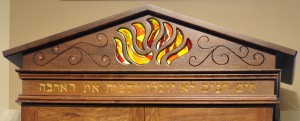
The top of the Aron Hakodesh (holy Ark) with the Hebrew passage taken from the Song of Songs ("Mighty waters cannot extinguish our love.") Photo © Alexander Barkoff (All rights reserved. Copying is a violation of law.)
Beside the remarkable support of Gates of Prayer and its leaders, there are many heroes to be credited with Beth Israel’s phoenix-like turnaround. These include previous congregation presidents and executive board members who never gave up hope, rabbis hired in the wake of the disaster to serve dual purposes of a charismatic spiritual leader and a much-needed synagogue administrator and major financial assistance from within the congregation. The plight of the devastated synagogue with iconic images of Torah rescues in murky floods became a cause celebré for Jewish renewal in New Orleans and major benefactors such as the Jewish Federations of North America (JFNA) – formerly the United Jewish Communities (UJC) – and the Orthodox Union (OU) came to Beth Israel with funding and plans to aid in its recovery and reconstruction.
“I think the emotions have changed,” said Rabbi Uri Topolosky, the rabbi hired in 2007 to spark the synagogue’s recovery and aid in its spiritual observance. “Five years ago we were so focused on what we needed to have our shul restored. We needed a building. We were so focused on what we had lost in terms of the physical structure, in terms of the contents, we were still grieving. We’ve now turned the corner. We’re not talking about recovery. We’re talking about the future.”
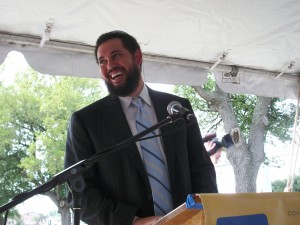
Rabbi Uri Topolosky, the charismatic spiritual leader of the now reborn Congregation Beth Israel. (©Alan Smason)
Topolosky and his wife Dahlia made the conscious decision to move to New Orleans with their two young sons (they also now have two young daughters) from the largely observant New York Bronx community of Riverdale, the site of the Yeshiva Chovevei Torah founded by Rabbi Avi Weiss, from where he was ordained a rabbi. Weiss, known as a prominent leader in the open Modern Orthodox movement, is slated to be a featured speaker at tonight’s Kiddush dinner as well as at Sabbath morning services and at the official dedication on Sunday morning.
Jaqueline “Jackie” Gothard, the Beth Israel president at the time of its devastation, is acknowledged as the primary author of then-101 year-old Orthodox congregation’s recovery. It was she who took the first tentative steps towards working with Gates of Prayer’s Rabbi Robert Loewy and temple administrator Louis Geiger. It was Gothard who rallied the dispersed members, suggesting a comeback from such a tragedy was possible. She single-handedly would organize tours of the devastated synagogue on Canal Boulevard to visitors who wanted to see the destruction first hand. With an executive board charged with responsibility of bringing the synagogue back, she arranged to interview several candidates for the pulpit at Beth Israel, among them Topolosky. She waxed with emotion as she recalled the interview process for the young rabbi and his ultimate effect on the congregation after his hiring. “I think he was a G-d-send,” she reflected. “It looked like we were not only choosing him, but he was also choosing us with the challenge of rebuilding a congregation.”
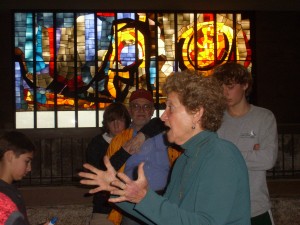
Former Beth Israel president Jackie Gothard, credited with getting the synagogue reorganized, gives an emotional tour to young visitors at the site of the Canal Boulevard synagogue. (©Alan Smason)
Encouraged by his wife, Topolosky embarked on his first solo rabbinate and a mission unlike any he had undertaken while an associate rabbi at Weiss’s own synagogue, the Hebrew Institute of Riverdale. “In New York there are so many Jews – the community is so large – it’s easy to get lost,” he continued. “It’s like you’re just a number in a community. We wanted to come to a place where your presence makes a difference. This is the kind of community that benefits from every single individual, so that’s wonderful.”
Gothard heaped additional praise on Topolosky and his effectiveness as the public face of Beth Israel. “What Rabbi Uri has given us more than we could have expected, was his outreach abilities within the community, his attraction to young families that have really been an aspect of our regrowth,” she said. “He is a fabulous pulpit rabbi. He is always prepared and always there no matter who wants him.”
Even before Topolosky arrived, Gothard, along with the aid of her son Edward, then an executive board member and current current congregation president, flew to Milwaukee to alert the Orthodox Union (OU) of the significant plight of their synagogue. Their efforts began what turned into a substantial six-figure contribution from the OU to aid them in their recovery needs. “We knew the shul was under water,” she remarked. “We knew we had significant losses, but didn’t know the full extent of it.”
The executive vice-president of the OU at the time, Rabbi Tzvi Hersh Weinreb, took up the challenge of helping the beleaguered synagogue. “We were the second largest contributor to the Beth Israel rebuilding fund,” he stated. “I’m very excited we had a role to play in it and this is the fruit of our labor. We’re happy to have done it.” Like Weiss, Weinreb is expected to be a featured speaker at events throughout the weekend as the official representative of the OU.
Weinreb also spoke highly of Topolosky and his leadership. ” Rabbi Topolosky is a young star in the American rabbinate and if there’s anyone who can bring Beth Israel back to their new level, he’s the one to do it,” Weinreb beamed. “He’s just a warm person, a hard worker, a visionary and he’ s just a special person.”
Another critical person involved in the recovery effort was Roselle Middleberg Ungar, a third-generation member of Beth Israel, who also served as interim executive director of the Jewish Federation of Greater New Orleans following the departure of Eric Stilwell. Ungar was credited with implementing the proposed recovery plan with the UJC that stretched over several years. It was that plan that had been put into effect which her successor Michael Weil followed when he assumed the Federation’s executive director position.
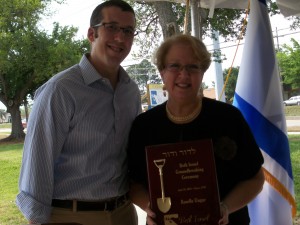
Roselle Middleberg Ungar with her son Hal, representing the third and fourth generations of membership at Congregation Beth Israel. (©Alan Smason)
After Jackie Gothard passed the reins of leadership to another former president, Myron Goldberg, the congregation continued to make plans to rebuild in earnest. Ungar assumed the Beth Israel presidency following Goldberg’s term and later had a pivotal role to play. A noted fundraiser for non-profit organizations, Ungar and her board launched a $3.5 million capital campaign and endowment to rebuild the synagogue and for the continued operation and administration costs of the synagogue. By the time she left office last, the campaign had achieved its goals, architects had drawn up plans after several meetings with congregants, contractors had been selected and the inspection process had begun. Commenting on what this dedication weekend will mean to her, Ungar noted: “I’m perpetuating a legacy of Modern Orthodoxy in New Orleans by being part of that group that made this happen and I’m just thinking how happy and proud my parents would be by all of this that’s happening.” With her efforts rewarded, Ungar is especially pleased with the way that the plans rendered by the architectural firm Brawer & Hauptman of Philadelphia and the general contractor Goliath Construction of Metairie turned out. “There’s an energy and excitement in the building,” she said. “You can feel it. Now we really have a place that we can call our own.”
Another critical phase of the synagogue’s recovery came when the congregation began interviewing candidates for an administrator in 2008. Rabbi David Posternock was selected to take on the daily tasks of synagogue administration, giving Topolosky the ability to concentrate on spiritual concerns and to continue his efforts in outreach. Posternock’s skill set included years of practical experience in the work force and the fact that he also was an ordained rabbi and could further assist Topolosky whenever there was a call turned out to be a welcomed addition. “I came here with speaking with (Rabbi) Uri when he was looking for a partner in rebuilding the shul,” Posternock said. “I felt very pulled with the mission.”
Through the last four years, Posternock has been called upon to administer the synagogue in an efficient manner, while helping to coordinate the rebuilding efforts and the operations of the synagogue on a daily basis. The temporary office was located in a small room leased in the Gates of Prayer building. “Through the process my resolve was tested quite a lot and quite often,” he continued, “but I’m proud to have been a stronger man having been through the process and I’m very proud of our congregation for standing strong and getting the job done.”

Synagogue administator Rabbi David Posternock sings a song to his newborn daughter Zoey as his wife Jessica and Rabbi Topolosky look on. (©Alan Smason)
Topolosky noted that beyond the dedication weekend and all of its formalities there lies a great deal of work left to be done. “What will be inside?” he questioned. “We want it to be a community center where all kinds of activities can take place. We’re in the infancy of where all kinds of things can happen.”
Aside from Weiss, his mentor and friend, Topolosky is also very familiar with Weinreb. A one-time resident of Silver Spring and undergraduate student at the University of Maryland, he knew Weinreb when he was the pulpit rabbi for a large Orthodox synagogue in nearby Baltimore. “Having two rabbis who are very prominent leaders in the Orthodox community, who perhaps represent somewhat different customs, and to bring that together is a wonderful statement of the kind of community we are,” he said. For his part as a representative of the OU, Weinreb, now the organization’s executive vice-president emeritus, noted that the “New Orleans Jewish community is an historic one, but there is room for growth, so we at the OU look forward to bringing it to the next level.”
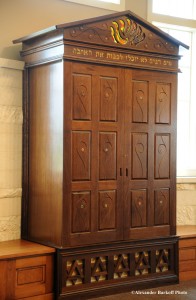
The handcrafted Ark designed by Israeli artist Gabriel Bass from African walnut. (Photo ©Alexander Barkoff )(All rights reserved. Copying is a violation of law.)
During the final construction phase the synagogue’s ritual design committee selected Israeli artist Gabriel Bass to construct original, unique mechitzah (separation) panels and an Aron Hakodesh (holy Ark) from African walnut. The hand-carved pieces feature glass inlay and a special passage taken from the Song of Songs that is carved in Hebrew. This passage was initially suggested by Topolosky, but because of its significance, the committee members readily concurred. “I’m very proud and moved by the quote that has been chosen to be on the Ark and in the lobby in English,” Topolosky said as he translated: “Mighty waters cannot extinguish our love.”
Weiss, when contacted by the CCJN, noted he was very much looking forward to his taking part in the dedication weeend and had a simple statement to offer: “Blessed are the builders and blessed are the proteges who become the teacher and rebbes of their rabbis.”


